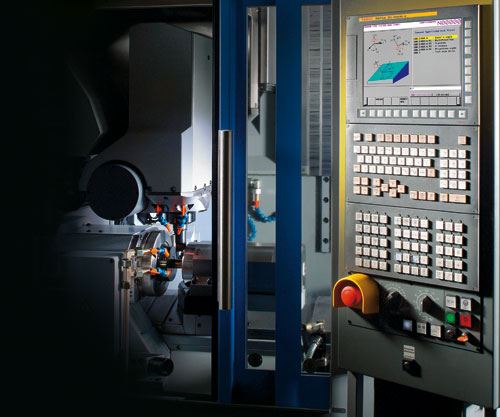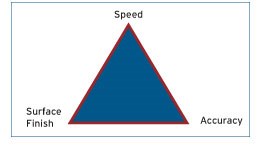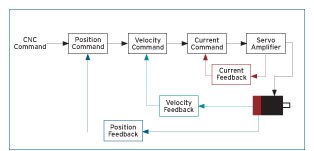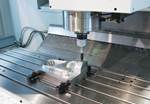A Practical Approach for Optimizing Your Machine, Part One
An in-depth look at optimization features embedded in your CNC waiting to be unleashed.
High-speed, high accuracy machining technologies combined with advanced servo and spindle technologies have given some advanced CNCs innovative capabilities to help increase the productivity of just about any machine tool. So, it is important to choose your CNC wisely. Many optimization features lie dormant in your CNC, waiting to be unleashed with a little investment.
Machine Performance
All machine tools have a boundary as to where it’s optimal performance lies. The performance boundaries can be best represented using a triangle (Figure 1) that shows the three keys to optimal performance: speed, accuracy and finish.
Each corner of the triangle represents your best possible outcome for each of the key performance features of which your machine is capable. The length of each side of this triangle represents the amount of trade off your machine needs to achieve these performance features. (In Figure 1 all sides are equidistant; this may not be the case in every application.)
For example, machine ‘A’ needs to produce parts with the best possible surface finish, the faster the program is run the more the surface finish is effected due to servo or mechanical inefficiencies, and as you climb the speed leg you also sacrifice accuracy due to accelerations, inertia and servo lag. Operating dead center of the triangle is not ideal either since operating in that region means you are sacrificing performance in all areas.
Optimization strives to reduce the length of each side of the performance triangle. The shorter the sides of the triangle, the faster, smoother and more accurate your machine tool can perform.
Benefits of Machine Optimization
The benefits of optimizing your machine can be quantified in the following areas:
Productivity: Reduced cycle time can be achieved through the effective use of efficient part program features, coupled with optimized servo and spindle performance. Optimizing surface finish and accuracy could significantly reduce the requirement for secondary operations such as deburring or grinding.
Accuracy: By optimizing servo performance and acceleration/deceleration profiles, position error is minimized allowing greater accuracy at higher speeds.
Prolonged Machine Life: By smoother application of servo power through advanced contour controls, machine shock can be significantly reduced without sacrificing speed or accuracy.
Prolonged Tool Life: Through spindle power and feedrate optimization, even chip load can be maintained prolonging tool life. Through the use of effective tool management techniques, less operator intervention is required resulting in fewer interruptions due to tooling issues.
Energy Efficiency: Energy usage is quickly becoming a significant portion of overall operating costs. Energy costs per part can be significantly reduced by optimizing machine performance. Better control of the spindle and servo systems coupled with more efficient part programming techniques and processing all contribute to reduce the machining time per part. Better accuracies and finish, which eliminate secondary operations, also contribute to the energy savings per part.
New Machine Optimization
A purchaser of a new machine might question the wisdom of optimizing a new machine, but there are many reasons optimization would be beneficial. New commodity machines are reliable, accurate, and well tuned straight from the factory. But the same machine tool purchased by one shop for mold and die making can also be used for high production mill-drill applications, or high accuracy aerospace or medical applications. In order to meet all these requirements and also maintain product standardization, the machines are tuned to “best fit” the variety of applications the machine was designed for.
Optimization helps to tailor your machine performance to meet the particular application requirements of your industry. Through specialized tuning and the addition of features, CNC optimization for new machines can capitalize on the mechanical capabilities of your machine.
Before attempting the optimization of a new machine tool, check with your machine tool builder to avoid any issues, which may affect your warranty. Also check with your machine tool builder to see if they offer any optimization services.
Older Machine Optimization
Older machines are prime candidates for optimization for a wide variety of reasons. Very often these machines are critical to production and costly to replace. As a machine is used, it wears and parts become loose. As a result, an older machine’s tuning and accuracy no longer meets factory specifications.
Servo tuning was based on original machine specifications and may be too aggressive for the current machine conditions. This could lead to instabilities, poor surface finish and the inability to achieve machining speeds of which the machine was once capable.
Compensations will most definitely need to be readjusted. Accuracy is affected by worn mechanics. Periodic compensation adjustments will keep the older machine’s accuracies to within tolerances. The addition of new types of compensation may be required as your machine ages (e.g., adding bidirectional pitch error or straightness compensation).
Features can be added to the CNC to allow the user to work around some of the mechanical deficiencies of an older machine and still provide optimal performance. Optimization allows your older machine to operate with the best possible performance within its mechanical capabilities.
Another consideration for older machines would be a complete CNC retrofit. This should only be considered for machines in good mechanical shape or machines that would be difficult to replace, but the controls and servos—due to their age—are incapable of providing the performance and reliability of which the machine is capable.
A thorough assessment of your older machine should be done by a qualified service person before attempting to optimize your machine. Screws, racks and ways need to be in good condition and not excessively worn or damaged. The machine positioning must be repeatable (it does not have to be accurate, inaccuracy can be compensated for, but that inaccuracy must be repeatable every time the machine returns to that position). If your machine is not repeatable, you have a much deeper problem that cannot be compensated for at the CNC level. Do not attempt to optimize a CNC on your own. Seek the advice of your machine tool builder or the CNC manufacturer. Optimization should only be performed by factory trained personnel.
Optimizing Basic Performance
Servo Tuning: Servo tuning is one of the most basic optimization tools. Servo tuning can be done to any machine at any time and usually yields the best results. Many people take servo tuning for granted and fail to realize that servo performance is directly related to part finish and tolerance. Servo tuning could be adjusted (and should be checked periodically) at any stage in a machine tool’s life. Good servo tuning can help your machine tool achieve smoother more precise axes control, faster cycle times, better path accuracy and extended machine life. Following are benefits as they relate to servo tuning:
Smoother More Precise Axes Control: Machine tool servo systems are referred to as closed loop systems, which means that as a command is generated to move the axes, feedback is provided by the servo-controlled axis to confirm the axis is properly responding to the command. The command is constantly adjusted based on the feedback and command, in order to ensure the axis is following the program path. There are three basic servo control loops. The current loop is used to control the fine commutation of the motor as well as the application of the motor torque. The velocity loop is used to ensure the servo motor is running at the proper speed and that the speed is applied smoothly. The position loop is used to ensure the axes position is accurate, keeping the axes on the program path (Figure 2).
Poorly tuned servo control loops can actually have the loops fighting each other resulting in instabilities and path errors. A well tuned servo control loop results from assuring that all the previously stated control loops are working together to provide the smoothest operation, quickest response, best possible path accuracy.
Faster Cycle Times: Servo tuning can aid in achieving faster cycle times in several ways. A well tuned servo system is capable of accelerating and decelerating the servo axes quicker and with less shock. The faster the axes can respond to speed changes in the part program, the shorter the overall cycle time can become. A well tuned servo system will also provide more stable operation at higher feedrates, allowing for faster cutting speeds (depending on and limited to machine condition, tooling and material). In addition, tuning a servo system will allow the axes to respond quicker to changes in axes load due to heavy cuts or inconsistent material.
Better Path Accuracy: As part of the servo tuning procedure, the loop gain for each control loop is adjusted to perform at its peak. The loop gain refers to the ability of the servo system to follow the program path (see Figure 3). All servo systems lag the commanded position slightly. The amount of servo lag in an axes is directly related to how well tuned the servos are.
Servo lag also increases with speed. So a well tuned servo system allows for much higher position loop gains, which in turn, reduces the amount of servo lag—providing much closer path accuracy and a more precise part.
Extended Machine Life: A well tuned servo system accelerates and decelerates smoother and moves smoother. Because of this, mechanical shock to your machine is reduced extending the mechanical life of the machine. In addition, the ability of the axes to handle changes in cutting load—with little or no effect to servo response—allows the machine to maintain a constant velocity with no vibration, further reducing mechanical shock.
Spindle Tuning: Often spindle motors are overlooked in the tuning process. Tuning a spindle to optimize velocity control improves the spindle’s ability to maintain speed and reduces the possibility of tool chatter. Tuning and optimizing spindle acceleration performance provides better speed response, faster tapping cycles and more accurate threading cycles. Tuning positioning and orientation on a spindle helps with faster tool changes better positioning and a stable platform for probing.
Summary
Up to this point we have discussed simple, low-cost improvements that can be done to any CNC system with minimal investment in time and money. In next month’s Part Two of “A Practical Approach for Optimizing Your Machine”, we will cover more advanced optimization techniques and features, which may be more specialized based on the machine application and CNC capabilities.
Related Content
The Benefits of Hand Scraping
Accuracy and flatness are two benefits of hand scraping that help improve machine loop stiffness, workpiece surface finish and component geometry.
Read MoreOEE Monitoring System Addresses Root Cause of Machine Downtime
Unique sensor and patent-pending algorithm of the Amper machine analytics system measures current draw to quickly and inexpensively inform manufacturers which machines are down and why.
Read MoreHow to Eliminate Chatter
Here are techniques commonly used to combat chatter and guidelines to establish a foundation for optimizing the moldmaking process.
Read MoreThe Trifecta of Competitive Toolmaking
Process, technology and people form the foundations of the business philosophy in place at Eifel Mold & Engineering.
Read MoreRead Next
How to Get the Most Out of Your Control
If the spindle is the heart of the machining center, the control is the brain. This article will help you explore whether it’s time to expand your brain and find new efficiencies to increase profitability.
Read MoreAre You a Moldmaker Considering 3D Printing? Consider the 3D Printing Workshop at NPE2024
Presentations will cover 3D printing for mold tooling, material innovation, product development, bridge production and full-scale, high-volume additive manufacturing.
Read MoreHow to Use Strategic Planning Tools, Data to Manage the Human Side of Business
Q&A with Marion Wells, MMT EAB member and founder of Human Asset Management.
Read More




















.jpg;maxWidth=300;quality=90)








